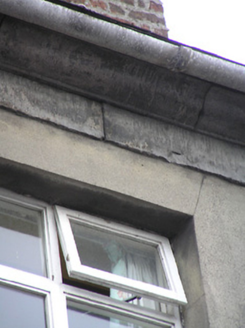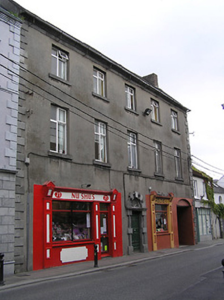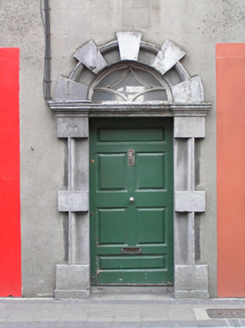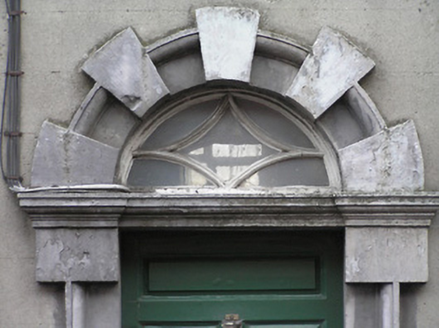Survey Data
Reg No
12000168
Rating
Regional
Categories of Special Interest
Architectural, Historical, Social
Original Use
House
Historical Use
RIC barracks
In Use As
House
Date
1765 - 1785
Coordinates
250918, 155984
Date Recorded
16/06/2004
Date Updated
--/--/--
Description
Terraced five-bay three-storey house, c.1775, with square-headed carriageway to right ground floor, and single-bay three-storey lower central return to south having two-bay three-storey gabled flanking bay continuing into single-bay two-storey return. Subsequently in use as Royal Irish Constabulary barracks, c.1850-c.1925. Extensively renovated, c.1925. Renovated, pre-1992, with pair of shopfronts inserted to ground floor. Pitched roof (hipped to central return; gabled to flanking bay) with replacement artificial slate, c.1925, red brick Running bond chimney stacks, and iron rainwater goods on moulded cut-limestone eaves (on rendered eaves to rear (south) elevation). Unpainted rendered, ruled and lined wall to front (north) elevation with cut-limestone quoins to corners, random rubble limestone wall to side (west) elevation having red brick irregular bond section to gable, and unpainted roughcast walls to remainder. Square-headed window openings with cut-stone sills, and replacement timber casement windows, c.1925. Round-headed door opening with cut-limestone Gibbsian surround, and timber panelled door having fanlight. Square-headed carriageway to right ground floor in elliptical-headed recess with replacement tongue-and-groove timber panelled double doors, pre-1992. Pair of timber shopfronts, pre-1992, to ground floor with panelled pilasters, fixed-pane timber windows, glazed timber doors having overlights, fascias having consoles, and moulded cornices. Road fronted with concrete footpath to front.
Appraisal
An elegantly-appointed Classically-proportioned large-scale house forming a prominent landmark in the streetscape of John Street Lower on account of the sizeable footprint together with the solid appearance of the form and massing. Despite renovation works over the course of the twentieth century that have led to the loss of much of the original fabric the elementary composition attributes survive largely intact, thereby maintaining much of the integrity of the site. Cut-limestone dressings displaying high quality stone masonry with particular emphasis on a finely-carved Gibbsian doorcase enliven the architectural design aesthetic of the composition: however, shopfronts of little inherent design distinction have not had a beneficial impact on the external expression of the site at street level. The house is of additional importance in the locality for the historic use as a Royal Irish Constabulary barracks, thereby representing an early civic institution in Kilkenny.







